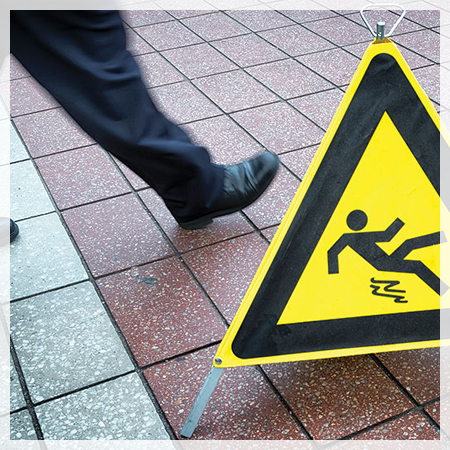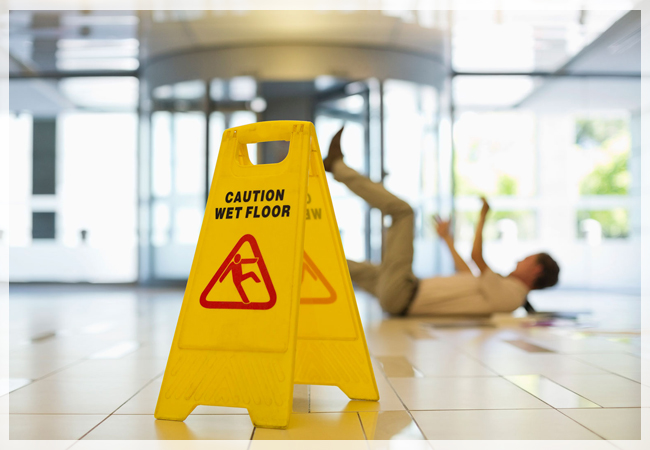Currency
October 08, 2017

The Walk Zone Safety Report could be a good resource for your next training session on walking-working surface safety. Many organizations underestimate floor safety risks and are unaware of high-risk walk zones in their buildings, according to a survey conducted by New Pig. The result: significant liability, medical costs, productivity losses and damage to brand reputation. New Pig surveyed professionals in maintenance, safety, health risk and facilities management across multiple industries.
What your workers should know: Same-level slip and fall accidents are the leading cause of workplace injuries, totaling nearly 200,000 in 2015, according to the U.S. Bureau of Labor Statistics. The 2017 Liberty Mutual Workplace Safety Index reports that these types of falls resulted in almost $11 billion in workers’ compensation and medical costs last year.

All fall-related survey questions focused only on same-level falls, excluding falls from heights. Key takeaways for your training sessions on samel-level falls:
** Risk zones are severely underestimated. Forty-six percent of respondents believe there are only 0-3 same-level fall risk areas in their facility. Yet the survey revealed more than 10 different locations identified as common fall locations. There is a disconnect between perceptions and the true scope of the challenge.
** Unguarded risk zones: customer walkways (14 percent reported falls here); employee walkways (24 percent reported falls); kitchens (nine percent); water fountains (three percent); bathrooms (six percent); frequent spill areas (20 percent); around equipment and machinery (23 percent); transition areas (23 percent); and entranceways (51 percent).
** Most risk zones are not addressed. Ninety-two percent of organizations place floor mats in entranceways; all nine of the other most dangerous risk zones go uncovered by the majority of organizations.
** Popular solutions cause falls instead of preventing them. Nearly 15 percent of organizations reported that wrinkled, bunched-up or shifting rubber-backed floor mats are the primary reason for falls in their building.
** Customer walkways are a major problem area. Less than one third (31 percent) of respondents reported placing floor mats in customer walkways, even as nearly one in four (24 percent) experienced falls in those areas.
** Survey results indicate that 51 percent of organizations identified the entranceway as the location of most slips, trips and falls in their building. The likely cause of many of these was rain and snow, which was identified as the primary cause of falls by 37 percent of respondents.
** Less than half of respondents address other fall zones – beyond entranceways – with floor mats, leaving these areas completely unprotected. These include the areas around equipment or machines (covered by a floor mat by 35 percent of respondents), employee walkways and aisles (24 percent), transition areas (20 percent) and kitchens (nine percent).
** Most respondents (54 percent) are not aware of the final OSHA Walking-Working Surfaces rule, which took effect in January of 2017. The standard provides employee safety standards for a wide range of workplaces. Only 29 percent reported meeting the rule’s requirements.
Your workforce should also be trained to recognize these fall hazards:
-- Rain and snow (37 percent of organizations reported weather elements as the primary cause of falls in their building)
-- Rubber-backed mats (15 percent primary cause)
-- Machinery leaks, drips and spills (8 percent)
-- Spilled liquids (11 percent)
-- Wet floors after cleaning (6 percent)
What your workers should know: Same-level slip and fall accidents are the leading cause of workplace injuries, totaling nearly 200,000 in 2015, according to the U.S. Bureau of Labor Statistics. The 2017 Liberty Mutual Workplace Safety Index reports that these types of falls resulted in almost $11 billion in workers’ compensation and medical costs last year.

Key findings
All fall-related survey questions focused only on same-level falls, excluding falls from heights. Key takeaways for your training sessions on samel-level falls:
** Risk zones are severely underestimated. Forty-six percent of respondents believe there are only 0-3 same-level fall risk areas in their facility. Yet the survey revealed more than 10 different locations identified as common fall locations. There is a disconnect between perceptions and the true scope of the challenge.
** Unguarded risk zones: customer walkways (14 percent reported falls here); employee walkways (24 percent reported falls); kitchens (nine percent); water fountains (three percent); bathrooms (six percent); frequent spill areas (20 percent); around equipment and machinery (23 percent); transition areas (23 percent); and entranceways (51 percent).
** Most risk zones are not addressed. Ninety-two percent of organizations place floor mats in entranceways; all nine of the other most dangerous risk zones go uncovered by the majority of organizations.
** Popular solutions cause falls instead of preventing them. Nearly 15 percent of organizations reported that wrinkled, bunched-up or shifting rubber-backed floor mats are the primary reason for falls in their building.
** Customer walkways are a major problem area. Less than one third (31 percent) of respondents reported placing floor mats in customer walkways, even as nearly one in four (24 percent) experienced falls in those areas.
** Survey results indicate that 51 percent of organizations identified the entranceway as the location of most slips, trips and falls in their building. The likely cause of many of these was rain and snow, which was identified as the primary cause of falls by 37 percent of respondents.
** Less than half of respondents address other fall zones – beyond entranceways – with floor mats, leaving these areas completely unprotected. These include the areas around equipment or machines (covered by a floor mat by 35 percent of respondents), employee walkways and aisles (24 percent), transition areas (20 percent) and kitchens (nine percent).
** Most respondents (54 percent) are not aware of the final OSHA Walking-Working Surfaces rule, which took effect in January of 2017. The standard provides employee safety standards for a wide range of workplaces. Only 29 percent reported meeting the rule’s requirements.
Key hazards
Your workforce should also be trained to recognize these fall hazards:
-- Rain and snow (37 percent of organizations reported weather elements as the primary cause of falls in their building)
-- Rubber-backed mats (15 percent primary cause)
-- Machinery leaks, drips and spills (8 percent)
-- Spilled liquids (11 percent)
-- Wet floors after cleaning (6 percent)









